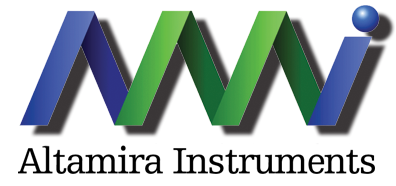EXPERIMENTAL
A known supported nickel catalyst was used as the reference material for this series of experiments... metal loading by weight: 17.7% ... metal surface area: 30 m2/g ... metal dispersion: 26%. Hydrogen pulse chemisorption and temperature-programmed desorption (TPD) were performed using an AMI-1 Catalyst Characterization System (Altamira Instruments). For the purpose of these experiments, the following definitions of dispersion, metal surface area and crystallite size were used:
Dispersion of Nickel:

Metal Surface Area:

Ni (0) Crystallite Size

Where:
U = amount gas chemisorbed (mole/g cat)
P = stoichiometry (mole gas/mole metal) (=0.5 for Ni-H2)
A = atomic weight metal (58.71 g/mole)
W = weight fraction of metal in catalyst POPRAWIC
Vg = volume gas chemisorbed at STP (1 mole = 22400 ml) = area of surface metal atom (Geus, Schwarz) = 6.17
A2 = 6.1710-20m2 N = Avogadro number 6.02245 1023
V = Volume crystal
S = Surface
D = dispersion (not in %)
PULSE CHEMISORPTION
Pulse chemisorption was initially selected because it is a simple technique, it distinguishes between physisorption and chemisorption, and it provides direct information about accessible, catalytically active sites.
In this group of experiments, the nickel sites were titrated with hydrogen. Physisorbed hydrogen was continuously purged from the surface of the catalyst. The number of pulses per experiment ranged from 25 to 35 and the time between pulses was four minutes. The pulse volume was 50 microliters and the gas flow rate of both hydrogen and argon was 40 ml/min.
Influence of Catalyst Weight
For the first series of chemisorption experiments, two runs, one with 25 pulses and one with 35 pulses, were performed on each of three sample weights. Figure 1 shows that the sample weight has a significant effect on chemisorption curves with larger samples causing a significant broadening of the signal. From these three curves it is apparent that the 0.1014 g sample weight, represented in Figure 1.C, gave the best results in terms of the sharpest peaks and least amount of base line drift. Figure 2 gives the calculated dispersion, crystallite size and metal surface area for the six runs. Unfortunately, neither the results of the 0.1788 g nor the 0.1014 g samples match the reference data thus indicating that either 35 pulses were not enough to obtain full coverage or other parameters needed to be optimized.
TEMPERATURE-PROGRAMMED DESORPTION
TPD was selected because it too is a fast technique that quantifies percent dispersion, metal surface area, and crystallite size. TPD has the added advantage of providing information about the thermodynamics of the catalyst system.
For this series of experiments, hydrogen was adsorbed at a flow rate of 30 ml/min. The time and temperature of adsorption was varied for each run. Physisorbed hydrogen was purged from the surface of the catalyst and the chemisorbed hydrogen was then desorbed by ramping up to a maximum temperature. For TPD, the time and temperature of the adsorption step must be optimized in order to achieve full coverage of the surface.
Influence of Adsorption Time and Temperature
Three TPD experiments were performed, one in which hydrogen was adsorbed at 303 K for 60 minutes, the second in which hydrogen was adsorbed at 333 K for 60 minutes and the third in which hydrogen was adsorbed at 303 K for 180 minutes. From the previous chemisorption experiments, it was known that higher temperatures should be avoided, therefore TPD was not performed at 363 K. Comparing the TPD curves in Figure 5 and the calculations in Figure 6, the second and third runs gave the best results in terms of peak deconvolution and matching the reference data.
CONCLUSIONS
In conclusion, these experiments show that both pulse chemisorption and temperature-programmed desorption are easy and powerful techniques that quantify dispersion, metal surface area, and crystallite size.
In the case of pulse chemisorption, one must optimize sample weight and temperature. The disadvantage of this technique is that the end-point is sometimes difficult to determine. Also, optimization depends on the catalyst type.
For TPD, adsorption time and temperature must be optimized. TPD is advantageous because results are very reproducible and test parameters need not be changed when analyzing different types of nickel catalysts.
In the case of this QC method for nickel hydrogenation catalysts, it was determined that hydrogen TPD was a preferable procedure to hydrogen pulse chemisorption. After running a number of hydrogen TPD experiments, a 95% confidence interval of 26.0 - 27.8% dispersion was determined. The researcher now runs this TPD procedure at least once per week for quality control purposes. Any results which fall outside the confidence interval are investigated. Figure 7 shows the data logged from 14 QC runs. The researcher notes that run 13, which shows a percent dispersion well outside the acceptable range, was actually due to a leaking flow controller.
Experimental data was provided by Dr. Ir. Luc Martens at Exxon Chemical International, Inc. in Machelen, Belgium.




